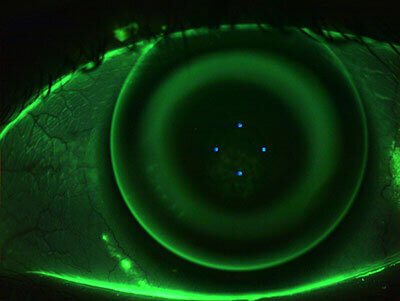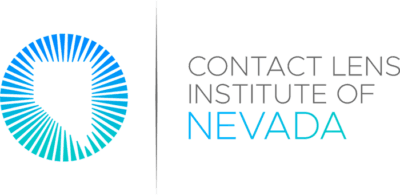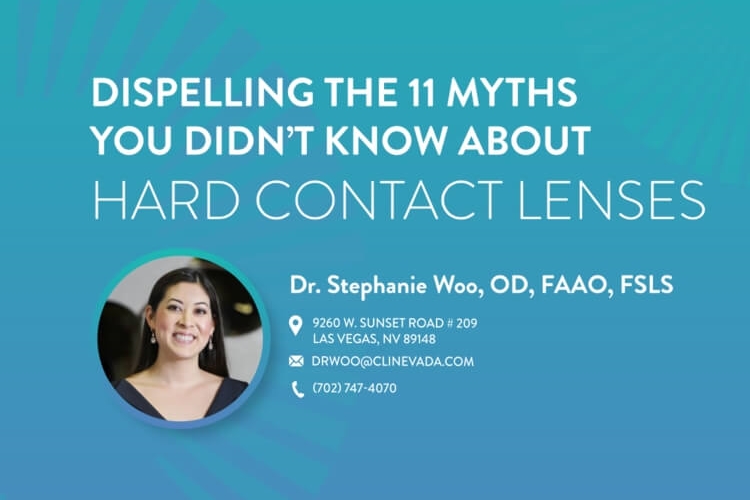What is Orthokeratology?
Orthokeratology describes the use of a specially designed contact lens during sleep to reversibly and temporarily reshape the cornea in order to see clearly during the day. This is similar to wearing braces but for your eyes! Although the effects are reversible, the benefits of this treatment can be maintained with consistent use. This type of lens is available for patients who are myopic or near sighted. It may to a lesser extent correct astigmatism (a football shaped eye), hyperopia (farsightedness), and presbyopia (trouble with near vision as you age). In some cases, this type of lens is used to slow the progression of childhood myopia. Orthokeratology allows for an alternative to surgery that eliminates the use of glasses or contacts during the daytime. Gas permeable lenses, made of a sturdy material, are used to help reshape the eye throughout the duration of sleep. The lenses must be used every night in order to maintain clear crisp vision. If lens wear discontinues, the need to wear glasses or contacts will return. This lens is a good option for patients who participate in contact sports, work in dusty environments, or are not candidates for refractive surgery. Schedule an exam with your eye doctor to determine if orthokeratology lenses would be the right fit for you!
How does it work?
The cornea (front surface of your eye) is a clear domed surface that focuses light into the eye and onto the retina. It is responsible for produces clear vision. In myopia (near sightedness), the cornea is too powerful and focuses the light prematurely. This results in blurry vision. Your eye doctor will map out the surface of your cornea using special technology such as a corneal topographer. This machine will simply take a photo of the eye and analyze it. It is a painless procedure. A corneal topographer will map out the shapes and curvature of the front of the eye. This will allow your doctor to design a lens that is specifically made for you. After a thorough exam, your eye doctor will determine if you are a good candidate for this lens. Based on all information gathered, your eye doctor will order custom lenses for you. The lenses used are gas permeable lenses which are made of a sturdy material to help reshape the eye. The lenses are designed flatter in the center of the cornea, gently flattening the cornea throughout the night. The flattening of the cornea reduces the power of the eye and allows for light to reach the retina to produce a clear image. In the morning, the lenses will be removed, and the cornea will remain flattened during the daytime. Over the duration of the day, the original shape of the cornea will resume, and the refractive error will return. Therefore, the sharpness of vision will gradually decrease over time. To maintain the clear vision, the lenses would need to worn regularly at night.
Is it safe?
The risks of orthokeratology are similar to that of a typical soft contact lens. The most serious risk involves decreasing oxygen to your eye during sleep. However, the material that orthokeratology lenses are made of allows for more oxygen to go through than soft contact lenses. Like any contact lens, it can be associated with corneal infections (microbial keratitis). This is typically seen in patients with poor contact lens hygiene or poor hand hygiene. The reshaping of the cornea is a temporary effect and therefore little risk is involved. You can stop using these lenses at any time. This is also not a surgical procedure, so the risks of complications associated with refractive surgeries are not a consideration here. The lenses cannot be lost behind the eye due to the structures surrounding the eye. If you experience any pain, light sensitivity, stinging, or persistent redness of the eye, contact your eye doctor immediately.
What can you expect?
Due to the personalized nature of orthokeratology, the use of multiple lenses to reach the desired visual goal may be required. This requires multiple follow ups to ensure you are using the best lens for you and are on track to reaching the desired prescription. It can take two weeks or more to obtain the maximum vision potential from these lenses. However, some people can notice significant improvements in just a few days. The higher the prescription, the longer it taxes for maximum correction. Adaptation is also required as you will be initially aware of the lenses as you sleep. With time, this will become more comfortable. Once your eye doctor determines that you have achieved the desired final corneal curvature with the lenses then you will use this lens to maintain your vision every night. Until your best vision is achieved, you may notice some blurry vision and halos around lights. You may need to wear glasses with a lower prescription in the adaptation process to provide you with the best vision. Remember, the best results require commitment from the patient in terms of consistent wear and regular office visits.
How much does ortho-k cost?
The process of fitting a patient for a lens this specially designed requires time and expertise. It requires multiple office visits and multiple sets of lenses. Every doctor will have their own fees and prices may vary across offices. The price can vary based on type and strength of your refractive error. The length of use of the lenses may determine cost as well. In general, the range is from $1,000 to $2,000 for both eyes. This is typically half the cost of LASIK. However, in very complex cases the cost may go up to as much as $4,000. There are costs related to lens replacement, lens care solutions, and follow up exams as well. Insurance may cover a portion of the fees but again, this varies by plan. Speak to both your eye doctor and your insurance company to see what this treatment plan would cost for you. Patients who desire good vision without the use of contacts during the day and without surgery may find that the benefits outweigh the cost of orthokeratology.
How does this lens limit the progression of myopia in children?
Studies have shown that children who are developing myopia at a faster rate than others may benefit from the use of orthokeratology lenses. This is because the rigid nature of the lenses limits stimulation for corneal growth. This growth is correlated with an increase in myopia due to an increase in eye power. This means that light will not focus on the back of the eye perfectly like we need it to in order to maintain clear vision. Speak to your eye doctor to see if this is a good option for your child.
Can I still do LASIK after using orthokeratology?
Yes! Orthokeratology is reversible so your cornea will go back to how it is naturally with discontinued use. If you use orthokeratology for a while and then decide you want to undergo refractive surgery instead, that is still an option for you. However, you must discontinue the lenses and wait a certain period of time before surgery to fully allow the natural shape of the eye to return. This may take 2 weeks up to a few months in some patients.
How do you insert the lenses into your eyes?
The process of insertion is similar to that of a soft contact lens. Simply place the lens on your finger and apply it directly to the colored part of the eye. Developing a routine, such as inserting right lens before left, will minimize the risk of inserting the wrong lens. Your eye doctor will show you how to safely insert and remove the lenses to maintain good lens hygiene.

How do you care for the lenses?
Always wash and rinse your hands thoroughly before inserting the lenses. Dry your hands with a lint free towel or tissue before touching the lenses. Do not allow tap water to come into contact with the lenses due to the presence of microorganisms such as acanthamoeba. Use a peroxide cleaner or multipurpose solution to clean, disinfect, and condition the lenses. Some acceptable examples include Boston Simplus, Menicare, or Clear Care. Do not use soft contact lens solutions to clean or store the lenses. Replace your contact lens case every 2-3 months to avoid microbial infections. If you notice any damage to your lenses, such as scratches or chips, contact your eye doctor for a replacement. Proper lens hygiene is imperative to maintaining clear vision and healthy eyes.

